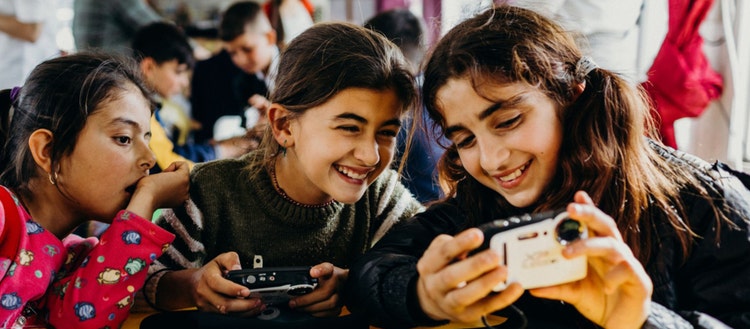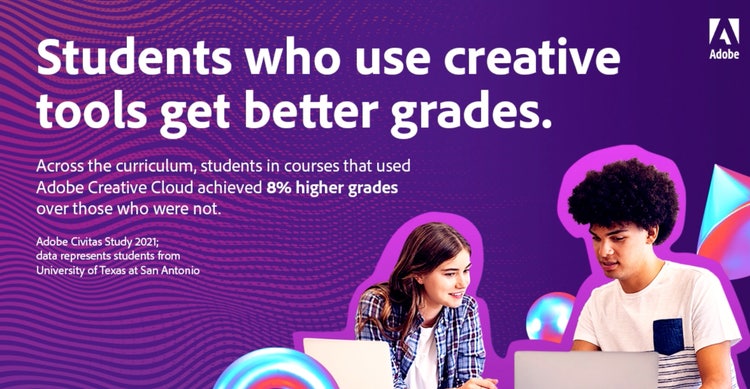An essential 21st century skill: digital literacy empowers youth to create change in the world and succeed in school and beyond

Photo courtesy of 100cameras.org.
Today’s youth are making history. As the first full generation of digital natives, they are growing up surrounded by ever-advancing technology such as personal computers, the internet, smartphones, social media, virtual reality, and more. Such ubiquitous exposure to visual technologies gives Gen Z an almost instinctive awareness of the power of imagery to shape people’s understanding of the world.
As young people progress through their academic journeys and into the workforce, they are learning digital and creative skills that enable them to become stronger visual communicators who harness the spectrum of technical mediums to influence the world around them. They can go beyond the written word to create videos, photos, presentations, and infographics that educate, raise awareness, and create deeper connections to critical issues such as climate change and social injustice. More than ever, digital creativity is empowering youth to excel in school and careers, as well as to promote global change.
At Adobe MAX 2021, we heard from some of the schools and organizations that are focused on helping students embrace creativity and master the essential 21st century skill of digital literacy. Through their program offerings, these organizations support students in making the leap from content consumer to content creator and changemaker.
University of Texas at San Antonio promotes academic success for all with Adobe
The University of Texas at San Antonio (UTSA) is committed to career preparation, giving students all the knowledge and skills they need to thrive. Accordingly, digital literacy has become a priority for UTSA. As an Adobe Creative Campus, UTSA provides all faculty, students, and staff equal access to Adobe Creative Cloud apps.

Photo courtesy of University of Texas at San Antonio (UTSA).
To understand the impact of bringing digital literacy learning into classrooms, UTSA participated in a study conducted in partnership between Civitas Learning, LinkedIn, and Adobe. The results exceeded expectations.
Across all students, those enrolled in courses using Adobe Creative Cloud achieved 8 percent higher grades than those who were not. Critically, the impact was even greater for key segments of the student population. Black and African American students earned 2.2x higher course grades. First-term students earned 2.4x higher course grades. Among students in the bottom quartile, 8 percent were more likely to return to school the next term — a significant boost in retention as even a 1 percent gain represents a key shift.

Beyond the classroom, creative skills also had a major impact on early career success. Recent graduates secured starting salaries up to 16 percent higher when they listed creative skills on their LinkedIn profiles. And over the past three years, professionals with creative skills saw up to 3x higher salary increases. This held true across all industries and roles, indicating that digital literacy is important for all students.
“By providing access to Adobe Creative Cloud applications, we support students in their digital storytelling and help them build skills that will support their future careers,” says Dr. Melissa Vito, vice provost for Academic Innovation at UTSA.
Watch the UTSA session from Adobe Max 2021.
Winston-Salem State University coaches students to serve the community
“Enter to Learn. Depart to Serve.” That is the motto that drives learning at Winston-Salem State University (WSSU). As a leading historically Black college and university (HBCU), WSSU aims to give its students the knowledge and tools they need to enact change upon communities and society as a whole.
“When students graduate, we charge them to serve,” explains Dr. Jack Monell, associate professor of Justice Studies at WSSU. “Social justice occurs in every community. I tell people to use their gifts, whatever they may be, to better others.”
Technology often plays a key role today in helping students address communities and draw attention to social issues. WSSU is the first HBCU to be designated an Adobe Creative Campus, and Monell incorporates Adobe Creative Cloud apps into his curriculum so students can learn to be better digital communicators.
In his social justice course, Monell challenges students to identify a social issue and work with a community partner to create solutions. Students capture field interviews and film videos of their work, bringing everything together in compelling Adobe Spark presentations aimed at their classmates and the community at large.

Image courtesy of Winston-Salem State University (WSSU).
Some WSSU social justice projects have already had a role in changing lives. In 2014, Dr. Denise Nation, associate professor of justice studies and department chair, developed a project focused on Ronnie Long, an African American man who was wrongfully convicted of assault in 1976. Professors within the Department of History, Politics, and Social Justice, incorporated Long’s story into curriculum and students responded in a big way, writing letters, and working with professors to arrange for protests on Long’s behalf. Students also used their digital savvy to launch a Twitter account and create video presentations using Adobe Spark and Adobe Premiere Rush to help raise awareness of Long’s story. After six years of campaigning, Long walked free in August 2020.
“When looking at social justice in an education environment, oftentimes the faculty or staff get all the praise, says Monell. “In this instance, students were on the front lines, using their creativity to develop content and strategies to amplify Ronnie Long’s case. We were just coaches. Students were the players.”
Watch the WSSU session from Adobe Max 2021.
Planet Forward supports student influence on world issues through digital journalism
After two decades at CNN, award-winning journalist Frank Sesno joined George Washington University to help inspire and be inspired by the next generation of voices. Sesno founded Planet Forward, a multimedia platform where students share stories that creatively teach, engage, and celebrate topics related to sustainability and the environment.
“Young people today have more information, reach, and influence at their fingertips than any previous generation,” says Sesno. “When they can use that energy to engage and mobilize their peers, they can do amazing things.”

Photo courtesy of Planet Forward.
Media professionals today often need to use visual elements, data, graphics, and animation to elevate their stories and craft narratives for a wider audience. That’s why at Planet Forward, Sesno and the program’s other mentors encourage student correspondents to push the envelope by finding new and creative ways of getting their stories across.
One correspondent, Terrius Harris, combines poetry and photography to showcase the juxtaposition of humans and creatures. Correspondent Francesca Edralin films documentaries that capture topics ranging from teenage climate change activists to using classroom gardening to address food insecurity in the Bronx.
Not all correspondents are journalists. Deepti Bansal Gage is an environmental law student who joined Planet Forward because she wanted to tell stories that would make people think more deeply about aspects of the world around them. For one storytelling project, she created an Adobe Spark page that focused on species conservation. She invited readers to choose a topic important to them—food, shelter, water, or medicine—and learn how even the tiniest creatures can impact those topics.
“Her Adobe Spark page offers audiences interactive opportunities, inviting people to click through or watch a video,” says Sesno. “It’s a very effective and thought-provoking way of engaging audiences. That’s what we say to our storytellers: give your audience ideas, images, and information that they won’t forget. That’s how Planet Forward has the potential to make such an impact.”
Watch the Planet Forward session from Adobe Max 2021.
100cameras amplifies youth voices with photography
100cameras is a nonprofit with a unique vision: teach youth around the world who have had challenging experiences to process and tell their stories through photography.
“All of the research we have shows us that if people don’t have the opportunity to feel seen and heard, they are statistically more likely to opt out rather than opt in,” explains founder and CEO Angela Popplewell. “We want to uplift and amplify the voices of youth in a way that positively impacts how they view themselves and their role in the community.”

Photo courtesy of 100cameras.org.
100cameras partners with local schools, youth organizations, and other leaders to create curriculum that teaches storytelling, self-expression, and photography skills to students. Photographs are then sold, either as prints through the 100cameras website or through Adobe Stock, with 100 percent of proceeds going back to the child’s community. The program gives youth an opportunity to express themselves as well as shows them the impact and value that their stories bring to their community.
Aundre Larrow, a visual artist who frequently collaborates with 100cameras, believes that the 100cameras model helps promote ethical storytelling — the idea of honoring a subject faithfully. All images curated and sold through 100cameras are taken from the perspective of a youth storyteller living within the community and honor the people, places, and world around them.

Photo courtesy of 100cameras.org.
“I love empowering children to tell their stories through photography,” says Larrow. “The 100cameras model teaches kids that their emotions matter, then it shows them that people value their work.
Watch the 100cameras session from Adobe Max 2021.
Changing the world through visual storytelling
We are constantly faced with digital messages, news, and information coming from our devices. Younger generations are learning how to harness the visual power of digital mediums and use creativity to cut through the noise, tell their stories, reach wider audiences, and start conversations that can change the world.